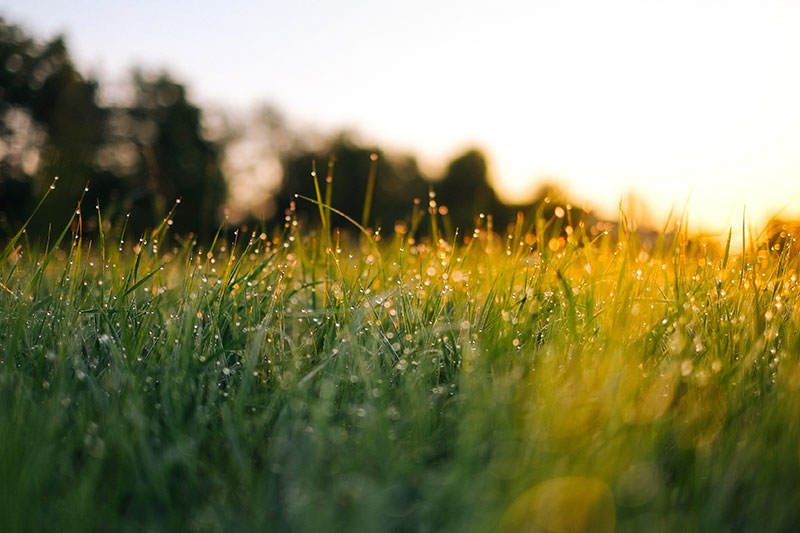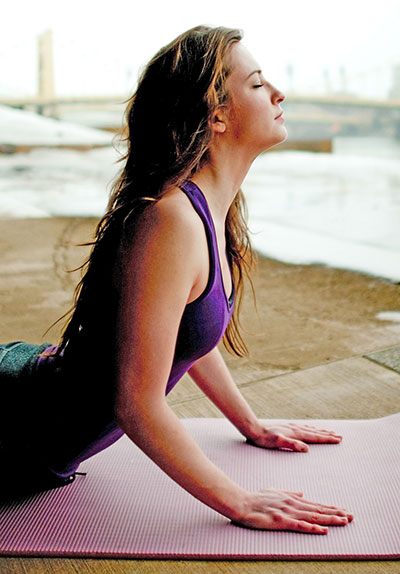Charaka Sutrasthaana, one of the principal Ayurvedic texts, dedicates several chapters to structuring a good daily rhythm.
To this day, its recommendations have lost none of their relevance. In fact, in turbulent times, it’s even more vital to have a stable foundation for one’s health.
A sensibly structured day serves as a guard rail for a balanced lifestyle and, in addition to health-promoting routines, also encompasses a personally appropriate diet, sufficient exercise, and restorative sleep. Its purpose is to secure the best possible quality of life and to utilize one’s full potential, by optimally connecting and harmonizing the inner and outer nature.
Of major importance for our consideration are the rhythms prescribed by nature, reflected in the basic energies and their changes over the course of the day. Each time of day has its own quality, closely related to the Doshas: Kapha, Pitta, and Vata.
Perhaps you have already observed in yourself that your digestive power, mood, and energy level can vary greatly at different times of the day. Besides many metabolic processes, these are precisely the aspects that are primarily controlled by the three Doshas.
Dinacharya is the knowledge of the cycles of the three Doshas and how to best use them for our health and vitality.

Starting the day the Ayurvedic way
According to Ayurveda, the day starts quite early, ideally even before 6 a.m. The Vedas state that a healthy person gets up in the first three hours of the day, i.e. between 3 and 6 o’clock in the morning. At first, this sounds very daunting and hardly tempting. However, it takes advantage of the energy quality of Vata, which is predominant between 2 and 6 a.m. During that time, the body is light and agile and getting up is much easier.
After 6 a.m., the Kapha period begins, which is more characterized by inertia and sluggishness. Therefore, just before 6 a. m., or at the latest just before sunrise, it can be easier to get up than much later, when the body feels rather tired and heavy.

The morning routine
The first recommendation is to drink a glass of warm water right after getting up, to wake up the gastrointestinal tract. Often, this stimulus is sufficient to induce emptying of the bowels as well as the bladder.
Next is mouth hygiene – several points
- Clean the surface of the tongue, either using a tongue scraper or a spoon, gently scraping from back to front. This not only removes coating, but also wakes up the internal organs, as they correspond with certain areas on the tongue and are thus stimulated.
- After cleaning the tongue, brush your teeth, preferably with an Ayurvedic toothpaste.
- Oil pulling (Kavala Graha): move a tablespoonful of oil around in your mouth for about five minutes, pushing and pressing it through the spaces between the teeth. At the end, you can gargle a little with it, which is especially beneficial for the throat and tonsils. Use sesame oil or coconut oil as preferred.
Oil pulling has many benefits for gums and teeth and binds toxins. Done regularly, teeth become whiter and less sensitive, as the oil provides a protective coating, which slows down the build-up of bacteria over the day.
You can read more about mouth hygiene here.
The following recommendation is to do a liquid cleansing of the nose. This is done with a ‘neti pot’ filled with lukewarm water in which you dissolve half a teaspoon of rock salt or Himalaya salt. To find demos online, search for ‘nasal rinse’ or ‘Jala Neti’. The salty water cleanses the nasal membranes, dissolves deposits and enhances your sensory perceptions. It is especially recommended for people with disorders of nose, throat, or thyroid gland. Ayurvedic nasal oil, sesame oil, and Ghee are also suited for a complementary treatment of the mucous membranes.
In the classical Ayurvedic texts, great importance is given to Abhyanga – self-massage. Daily Abhyanga is recommended, in order to cleanse the body and at the same time soothe the mind. After all, the skin is the largest organ of the human body, connected by nerve pathways and reflex arcs with all internal organs. By gently touching the skin, we connect naturally with ourselves and give ourselves loving attention.
At the same time, the whole metabolism is revitalized and all the innumerable transformation processes in the body are stimulated. Detailed instructions on how to give yourself this Ayurvedic oil massage and other interesting background information can be found in the article Self-Abhyanga – the easy oil treatment you can do at home.
Yoga, Meditation and Pranayama

In addition to the above routines to care for the body and optimally prepare it for the day ahead, also exercise, breathing exercises, and meditation play an important role in one’s well-being.
A gentle exercise in the morning on an empty stomach has a Kapha-reducing and Ama-reducing effect. You will feel refreshed and awake afterwards if the level of exertion is appropriate for your personal constitution. Plan at least 15 minutes for exercise in the morning and find something that you enjoy. Routines should provide structure and comfort, but should not lead to new stress. Possible ideas for exercise might be: a few sun salutations, a short, crisp walk in the fresh air, dancing to your favorite music, or bouncing on a trampoline. Be bold enough to experiment and keep adapting your routines to suit your needs.
After an exercise session, most people find that they can meditate and settle down much more easily. In general, morning time is very suitable for meditation, because the mind is still free and not burdened by everyday life. If you haven’t meditated before, just try sitting in silence for five minutes while observing inhalation and exhalation. It is perfectly okay if thoughts arise during this process. It is not the goal of meditation to have no thoughts at all, but to train your awareness of them and to let thoughts pass more quickly.
Breathing exercises, called pranayama, have an incredibly invigorating effect and bridge the interface between body and mind. Prana is the life energy, which can be increased through conscious breathing. Of the numerous different breathing exercises known in yoga, the light alternating breathing is suitable for everyone, including beginners. It is performed at the beginning or end of a yoga session and establishes balance in the body/mind.

A brief tutorial on alternating breathing: Use the thumb and ring finger of one hand to alternately hold the right and left nostrils closed, while breathing through the other nostril. Apart from that restriction, breathe naturally, without influencing the depth or the frequency. Begin with closing the right nostril and inhaling through the left one. Hold your breath briefly while changing the hand position, then exhale through the right nostril. Hold your breath again briefly, then inhale on the right, hold briefly, exhale on the left. Repeat for a few minutes.
Tip: Of course, it is best to learn meditation and alternating breathing from an experienced yoga or meditation teacher. In Maharishi Ayurveda, we especially recommend the Transcendental Meditation technique, as it is natural and effortless, highly effective, and scientifically the best studied of all forms of meditation.
Daily Schedule
It is very important, especially for people with a high proportion of Vata Dosha, to have a clear plan for the day, so that you don’t get lost in all the different tasks and unnecessarily experience additional stress. Also, while planning, you’ll want to consider at which time of the day the various activities can be done more easily:
The hardest tasks of the day are best tackled in the morning, as this is when steady, persistent Kapha energy prevails.
The most suitable time for doing planning and organizing is from 10 a.m. to 2 p.m., when there is a lot of Pitta energy.
Over the afternoon, Vata energy increases, making it a more favorable time to pursue lighter and creative work or develop new ideas.
Remember that, in addition to all the to-dos, also breaks should be scheduled in – they allow you to re-center before every next activity, instead of rushing through the day.

Sleep
In the evening, it’s recommended to take a light, vegetarian, warm meal between 5 and 7 pm. This is to make sure that the food is digested by the time you go to bed, so that the quality of your sleep is not affected.
Ayurveda recommends going to bed around 10 p.m. because that is the time when Pitta Dosha, the quality of transformation, increases – and this is just the type of energy necessary for metabolizing the food intake at the level of the body tissues, as well as for processing and integrating the ‘mental intake’ of the day. After such a transformative night’s rest, you’ll wake up profoundly refreshed and ready for action.
Staying up too long and eating late, heavy meals disturbs these processes enormously, especially if it becomes a habit. The result is that impurities (Ama) build up, causing heaviness in body and mind and, in the long run, disease.
When changing habits, you can incorporate small rituals into your evening routine which help to settle down and signal relaxation to the physiology.
Lavender oil can help you to smoothly slip into slumber: spray a little on your pillow, or dilute it with almond oil and give yourself a foot massage just before lying down – a delightful conclusion of the day.
Where to start?
Obviously, you can’t implement all of the above recommendations and change your lifestyle overnight. A great way to transition to a more beneficial daily routine is taking an in-residence Panchakarma course of treatment, where the reset is built in and you go home ‘soaked with Ayurveda.’
But on your own, you’ll have to move in small steps. What you can do is pick out a few points from the above list that are easy for you and start those from tomorrow. The important thing is to observe how you feel with them for some time, then decide how to go on: keep them, change them, maybe add another element?
It takes courage to embrace change, but remember that those around you benefit from a better you, maybe more than you yourself. It’s your life – the challenge is to adapt it to your needs and enjoy.
Wishing you a wonderful journey!

Download the article as a PDF file.
© Maharishi Ayurveda Health Centre Bad Ems


This is such beautiful advice– the whole routine for the day and night. I appreciate the tone of this article, it is very friendly and easy for me to listen to. These basic points about the changing energies of the day are so fundamental, I can see how aligning oneself to these different times can make everything in the 24 hour cycle go very smoothly, increasing one’s energy and well-being. The knowledge of Ayurveda is so practical.
Yes, Mr. Cesar,
Thank you for your nice and appreciative comment – and it is very true since Ayurveda really represents the knowledge about the laws of nature which support our wellbeing. Stay healthy and happy!
Dr Karina Pirc
Physician & Psychologist